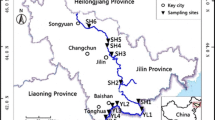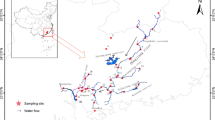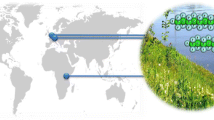Abstract
The current article maps perfluoroalkyl acids (PFAAs) contamination in the largest Science Park of Taiwan. The occurrence of ten target PFAAs in the effluent of an industrial wastewater treatment plant (IWWTP), its receiving rivers, rainwater, sediment, and the muscles and livers of fish was investigated. All target PFAAs were found in effluent of IWWTP, in which perfluorooctane sulfonate (PFOS) (6,930 ng/L), perfluorohexyl sulfonate (PFHxS) (2,662 ng/L) and perfluorooctanoic acid (PFOA) (3,298 ng/L) were the major constituents. Concentrations of PFBS and PFOS in the IWWTP downstream areas have exceeded safe concentration levels of avian and aquatic life, indicating a potential risk to wildlife in those areas. In sediment samples, predominant contaminants were PFOS (1.5–78 ng/g), PFOA (0.5–5.6 ng/g), and perfluorododecanoic acid (PFDoA) (nd–5.4 ng/g). In biological tissue samples, concentrations as high as 28,933 ng/g of PFOS were detected in tilapia and catfish liver samples. A positive correlation for log (C sediment/C water) and log (C tissue/C water) was found. The concentration and proportion (percentage of all PFAAs) of PFOS found in biotissue samples from the Keya River (which receives industrial wastewater) were found to be much greater (200 times) than those of samples from the Keelung River (which receives mainly domestic wastewater). These findings suggest that the receiving aquatic environments and, in turn, the human food chain can be significantly influenced by industrial discharges.






Similar content being viewed by others
References
Becker, A. M., Gerstmann, S., & Frank, H. (2008a). Perfluorooctane surfactants in waste waters, the major source of river pollution. Chemosphere, 72, 115–121.
Becker, A. M., Gerstmann, S., & Frank, H. (2008b). Perfluorooctanoic acid and perfluorooctane sulfonate in the sediment of the Roter Main river, Bayreuth, Germany. Environmental Pollution, 156, 818–820.
Calafat, A. M., Needham, L. L., Kuklenyik, Z., Reidy, J. A., Tully, J. S., Aguilar-Villalobos, M., et al. (2006). Perfluorinated chemicals in selected residents of the American continent. Chemosphere, 63, 490–496.
D’eon, J. C., Crozier, P. W., Furdui, V. I., Reiner, E. J., Libelo, E. L., & Mabury, S. A. (2009). Observation of a commercial fluorinated material, the polyfluoroalkyl phosphoric acid diesters, in human sera, wastewater treatment plant sludge, and paper fibers. Environmental Science & Technology, 43, 4589–4594.
Dreyer, A., Matthias, V., Weinberg, I., & Ebinghaus, R. (2010). Wet deposition of poly- and perfluorinated compounds in Northern Germany. Environmental Pollution, 158, 1221–1227.
Ellis, D. A., Martin, J. W., De Silva, A. O., Mabury, S. A., Hurley, M. D., Sulbaek Andersen, M. P., et al. (2004). Degradation of fluorotelomer alcohols: a likely atmospheric source of perfluorinated carboxylic acids. Environmental Science & Technology, 38, 3316–3321.
Furdui, V. I., Stock, N. L., Ellis, D. A., Butt, C. M., Whittle, D. M., Crozier, P. W., et al. (2007). Spatial distribution of perfluoroalkyl contaminants in lake trout from the great lakes. Environmental Science & Technology, 41, 1554–1559.
Giesy, J. P., & Kannan, K. (2002). Peer reviewed: perfluorochemical surfactants in the environment. Environmental Science & Technology, 36, 146A–152A.
Hatfield, T. (2001). Screening studies on the aqueous photolytic degradation of potassium perfluorooctane sulfonate (PFOS). 3M Environmental Laboratory. 3M Company, St. Paul, MN. Report number W2775.
Higgins, C. P., & Luthy, R. G. (2006). Sorption of perfluorinated surfactants on sediments†. Environmental Science & Technology, 40, 7251–7256.
Higgins, C. P., Field, J. A., Criddle, C. S., & Luthy, R. G. (2005). Quantitative determination of perfluorochemicals in sediments and domestic sludge. Environmental Science & Technology, 39, 3946–3956.
Huset, C. A., Chiaia, A. C., Barofsky, D. F., Jonkers, N., Kohler, H.-P. E., Ort, C., et al. (2008). Occurrence and mass flows of fluorochemicals in the Glatt Valley Watershed, Switzerland. Environmental Science & Technology, 42, 6369–6377.
Ji, K., Kim, Y., Oh, S., Ahn, B., Jo, H., & Choi, K. (2008). Toxicity of perfluorooctane sulfonic acid and perfluorooctanoic acid on freshwater macroinvertebrates (Daphnia magna and Moina macrocopa) and fish (Oryzias latipes). Environmental Toxicology and Chemistry, 27, 2159–2168.
Kärrman, A., van Bavel, B., Järnberg, U., Hardell, L., & Lindström, G. (2006). Perfluorinated chemicals in relation to other persistent organic pollutants in human blood. Chemosphere, 64, 1582–1591.
Kudo, N., & Kawashima, Y. (2003). Toxicity and toxicokinetics of perfluorooctanoic acid in humans and animals. Journal of Toxicological Sciences, 28, 49–57.
Kuklenyik, Z., Reich, J. A., Tully, J. S., Needham, L. L., & Calafat, A. M. (2004). Automated solid-phase extraction and measurement of perfluorinated organic acids and amides in human serum and milk. Environmental Science & Technology, 38, 3698–3704.
Kwadijk, C. J. A. F., Korytár, P., & Koelmans, A. A. (2010). Distribution of perfluorinated compounds in aquatic systems in the Netherlands. Environmental Science & Technology, 44, 3746–3751.
Li, L., Xu, Z. S., & Song, G. W. (2009). Study on the Langmuir aggregation of fluorinated surfactants on protein. Journal of Fluorine Chemistry, 130, 225–230.
Lin, A. Y.-C., Panchangam, S. C., & Lo, C.-C. (2009). The impact of semiconductor, electronics and optoelectronic industries on downstream perfluorinated chemical contamination in Taiwanese rivers. Environmental Pollution, 157, 1365–1372.
Lin, A. Y.-C., Panchangam, S. C., & Ciou, P.-S. (2010). High levels of perfluorochemicals in Taiwan’s wastewater treatment plants and downstream rivers pose great risk to local aquatic ecosystems. Chemosphere, 80, 1167–1174.
Liu, W., Jin, Y., Quan, X., Sasaki, K., Saito, N., Nakayama, S. F., et al. (2009). Perfluorosulfonates and perfluorocarboxylates in snow and rain in Dalian, China. Environment International, 35, 737–742.
Loganathan, B. G., Sajwan, K. S., Sinclair, E., Senthil Kumar, K., & Kannan, K. (2007). Perfluoroalkyl sulfonates and perfluorocarboxylates in two wastewater treatment facilities in Kentucky and Georgia. Water Research, 41, 4611–4620.
Moody, C. A., Martin, J. W., Kwan, W. C., Muir, D. C. G., & Mabury, S. A. (2002). Monitoring perfluorinated surfactants in biota and surface water samples following an accidental release of fire-fighting foam into etobicoke creek. Environmental Science & Technology, 36, 545–551.
Morikawa, A., Kamei, N., Harada, K., Inoue, K., Yoshinaga, T., Saito, N., et al. (2006). The bioconcentration factor of perfluorooctane sulfonate is significantly larger than that of perfluorooctanoate in wild turtles (Trachemys scripta elegans and Chinemys reevesii): an Ai river ecological study in Japan. Ecotoxicology and Environmental Safety, 65, 14–21.
OECD. (2002). Hazard assessment of perfluorooctane sulfonate (PFOS) and its salts. ENV/JM/RD(2002) 17/FINAL.
Prevedouros, K., Cousins, I. T., Buck, R. C., & Korzeniowski, S. H. (2006). Sources, fate and transport of perfluorocarboxylates. Environmental Science & Technology, 40, 32–44.
Quinete, N., Wu, Q., Zhang, T., Yun, S. H., Moreira, I., & Kannan, K. (2009). Specific profiles of perfluorinated compounds in surface and drinking waters and accumulation in mussels, fish, and dolphins from southeastern Brazil. Chemosphere, 77, 863–869.
Renner, R. (2001). Growing concern over perfluorinated chemicals. Environmental Science & Technology, 35, 154A–160A.
Saito, N., Harada, K., Inoue, K., Sasaki, K., Yoshinaga, T., & Koizumi, A. (2004). Perfluorooctanoate and perfluorooctane sulfonate concentrations in surface water in Japan. Journal of Occupational Health, 46, 49–59.
Senthilkumar, K., Ohi, E., Sajwan, K., Takasuga, T., & Kannan, K. (2007). Perfluorinated compounds in river water, river sediment, market fish, and wildlife samples from Japan. Bulletin of Environmental Contamination and Toxicology, 79, 427–431.
Sinclair, E., & Kannan, K. (2006). Mass loading and fate of perfluoroalkyl surfactants in wastewater treatment plants. Environmental Science & Technology, 40, 1408–1414.
Sinclair, E., Mayack, D., Roblee, K., Yamashita, N., & Kannan, K. (2006). Occurrence of perfluoroalkyl surfactants in water, fish, and birds from New York State. Archives of Environmental Contamination and Toxicology, 50, 398–410.
Taniyasu, S., Kannan, K., Horii, Y., Hanari, N., & Yamashita, N. (2003). A survey of perfluorooctane sulfonate and related perfluorinated organic compounds in water, fish, birds, and humans from Japan. Environmental Science & Technology, 37, 2634–2639.
Tseng, C.-L., Liu, L.-L., Chen, C.-M., & Ding, W.-H. (2006). Analysis of perfluorooctanesulfonate and related fluorochemicals in water and biological tissue samples by liquid chromatography–ion trap mass spectrometry. Journal of Chromatography A, 1105, 119–126.
U.S.EPA. (2002). Revised draft hazard assessment of perfluorooctanoic acid and its salts. In: Office of Pollution Prevention and Toxics Risk Assessment Division.
Wang, Y.-C., Lin, A. Y.-C., Wang, S.-L., & Ding, W.-H. (2012). Determination of perfluorochemicals in human milk using isotope-dilution liquid chromatography tandem mass spectrometry. Journal of the Chinese Chemical Society, 59, 544–549.
Yoo, H., Washington, J. W., Jenkins, T. M., & Laurence Libelo, E. (2009). Analysis of perfluorinated chemicals in sludge: method development and initial results. Journal of Chromatography A, 1216, 7831–7839.
Zushi, Y., Takeda, T., & Masunaga, S. (2008). Existence of nonpoint source of perfluorinated compounds and their loads in the Tsurumi River basin, Japan. Chemosphere, 71, 1566–1573.
Author information
Authors and Affiliations
Corresponding author
Rights and permissions
About this article
Cite this article
Lin, A.YC., Panchangam, S.C., Tsai, YT. et al. Occurrence of perfluorinated compounds in the aquatic environment as found in science park effluent, river water, rainwater, sediments, and biotissues. Environ Monit Assess 186, 3265–3275 (2014). https://doi.org/10.1007/s10661-014-3617-9
Received:
Accepted:
Published:
Issue Date:
DOI: https://doi.org/10.1007/s10661-014-3617-9




